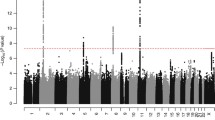Abstract
Purpose
A positive family history is an important risk factor for inguinal hernia development, suggesting a genetic trait for hernia disease. However, gene mutations responsible for abdominal wall hernia formation in humans have not yet been studied. We aimed to evaluate whether the functional Sp1 binding site polymorphism within intron 1 of the collagen type I, alpha 1 (COL1A1) gene was associated specifically with inguinal hernia disease.
Methods
85 participants with surgically diagnosed inguinal hernia disease, and 82 physically active controls without any history of connective tissue disease and hernia were recruited for this case–control genetic association study. Polymerase chain reaction and restriction fragment length polymorphism and agarose gel electrophoresis techniques were used to detect these polymorphisms.
Results
Significantly, more patients gave a positive family history for an inguinal hernia compared to healthy controls (OR 3.646, 95 % CI 1.375–9.670, P = 0.006). COL1A1 Sp1 SNP (rs 1800012) was identified. Results demostrated statistically significant deviation from HWE for cases (P = 0.007), but not for the controls (P = 0.276). Our results revealed an increased frequency of COL1A1 Sp1 Ss genotype in inguinal hernia patients (OR 3.593, 95 % CI 1.867–6.915, P = 0.000).
Conclusions
This results suggest that polymorphism of the COL1A1 Sp1 binding site is associated with an increased risk for developing inguinal hernias. So, rs 1800012 locus is a potential candidate region for susceptibility in molecular mechanism of inguinal hernia pathophysiology.

Similar content being viewed by others

References
Klinge U, Binnebösel M, Mertens PR (2006) Are collagens the culprits in the development of incisional and inguinal hernia disease? Hernia 10:472–477
Henriksen NA, Yadete DH, Sorensen LT et al (2011) Connective tissue alteration in abdominal wall hernia. Brıt J Surg 98(2):210–219
Rosch R, Junge K, Lynen P et al (2003) Hernia—a collagen disease. Eur Surg 35(1):11–15
Jansen PL, Klinge U, Mertens PR (2006) Hernia disease and collagen gene regulation: are there clues for intervention? Hernia 10:486–491
Keen RW, Woodford-Richens KL, Grant SF, Ralston SH, Lanchbury JS, Spector TD (1999) Associaton of polymorphism at the type I collagen (COLIAI) locus with reduced bone mineral density, increased fracture risk and increased collagen turnover. Artritis Rheum 42(2):285–290
Posthumus M, September AV, Keegan M et al (2009) Genetic risk factors for anterior cruciate ligament ruptures: cOL1A1 gene variant. Br J Sports Med 43:352–356
Franz MG (2008) The biology of hernia formation. Surg Clin North Am 88(1):1–15
Grant SF, Reid DM, Blake G et al (1996) Reduced bone density and osteoporosis associated with a polymorphic Sp1 binding site in the collagen type I alpha 1 gene. Nat Genet 14(2):203–205
Cambria RP (2011) Abdominal aortic aneurysm and abdominal wall hernia as manifestations of a connective tissue disorder. J Vasc Surg 54:1175–1181
Franz MG (2006) The biology of hernias and the abdominal wall. Hernia 10:462–471
Friedman DW, Boyd CD, Norton P et al (1993) Increases in type III collagen gene expression and protein synthesis in patients with ınguinal hernias. Ann Surg 218(6):754–760
Van Wessem KJP, Simons MP, Plaisier PW et al (2003) The etiology of indirect inguinal hernias: congenital and/or acquired? Hernia 7:76–79
Akbulut S, Cakabay B, Sezgin A (2010) A familial tendency for developing inguinal hernias: study of a single family. Hernia 14:431–434
Sioutis D, Economou E, Lambrinoudaki I, Tsamadias V, Creatsa M, Liapis A (2011) Sp1 collagen I A1 polymorphism in women with stress urinary incontinence. Int Urogynecol J 22(7):835–839
Ferrari MM, Rossi G, Biondi ML, Viganò P, Dell’utri C, Meschia M (2012) Type I collagen and matrix metalloproteinase 1, 3 and 9 gene polymorphisms in the predisposition to pelvic organ prolapse. Arch Gynecol Obstet 285(6):1581–1586
Simsek M, Cetin Z, Bilgen T et al (2008) Effects of hormone replacement therapy on bone mineral density in Turkish patients with or without COL1A1 Sp1 binding site polymorphism. J Obstet Gynaecol Res 34(1):73–77
Dinçel E, Sepici-Dinçel A, Sepici V et al (2008) Hip fracture risk and different gene polymorphisms in the Turkish population. Clinics 63(5):645–650
Jansen PL, Klinge U, Jansen M et al (2009) Risk factors for early recurrence after inguinal hernia repair. BMC Surg 9:18
Junge K, Klinge U, Rosch R et al (2004) Decreased collagen type I/III ratio in patients with recurring hernia after implantation of alloplastic prostheses. Langenbecks Arch Surg 389:17–22
Acknowledgments
This study was supported by a Grant from the Ankara Numune Education and Research Hospital, Research Foundation (project 129/2011). We thank BM R&D Molecular Biology Laboratory (Ankara, Turkey) for the technical support provided.
Conflict of interest
SS, NŞ, HTÇ, GE, GÖ, APD, FC and KD declares no conflict of interest that directly relates to this study.
Author information
Authors and Affiliations
Corresponding author
Rights and permissions
About this article
Cite this article
Sezer, S., Şimşek, N., Çelik, H.T. et al. Association of collagen type I alpha 1 gene polymorphism with inguinal hernia. Hernia 18, 507–512 (2014). https://doi.org/10.1007/s10029-013-1147-y
Received:
Accepted:
Published:
Issue Date:
DOI: https://doi.org/10.1007/s10029-013-1147-y



